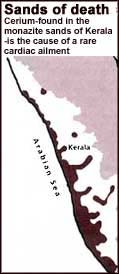


The Kerala coast, famed for its beaches, is home to a rare form of heart disease called endo-myocardial fibrosis (EMF). And scientists who conducted a 10-year-long study on EMF now blame the disease on a mineral called monazite in the fine, white sands of Kerala.
EMF belongs to a group of heart muscle diseases of "unknown cause". The heart muscles thicken and the volume of the heart decreases. This disease, of which only 779 cases have been reported worldwide in the past 2 decades, is endemic to the tropics and is found in India predominantly along the Kerala coast (Current Science, Vol 67, No 2).
M S Valiathan and his colleagues at the Trivandrum-based Sree Chitra Tirunal Institute for Medical Sciences and Technology have pin-pointed cerium -- a component of the monazite sands of Kerala -- as the cause. The researchers also discovered that the incidence of this disease is higher among poor children, who more often than nor suffer from magnesium deficiency.
Monazite sands comprise of phosphate minerals of elements such as cerium which occur as small brown crystals in the Kerala sands (these monazite sands are mined for both cerium and radioactive thorium oxide). The sands originate in the granites and gneisses of the Western Ghats and are transported to the coast by more than 47 streams that indent the Kerala coastline.
According to the researchers, pathological studies of heart tissue from 9 EMF patients showed elevated levels of cerium and thorium and a significant drop in levels of magnesium, as compared to controls. This finding led the researchers to explore the possibility that EMF may be caused by the replacement of magnesium by the highly toxic cerium.
The scientists believe that the cerium enters the patient's body through tubers consumed by them. Tubers like tapioca form the staple diet of the poor and are known to accumulate cerium from the surrounding sand in which they grow, far more so than other vegetables. In addition to this, food contaminated by sand could also have led to the accumulation of cerium in the body.
Links:
[1] http://admin.indiaenvironmentportal.org.in/news/kerala-beaches-kayo-heart
[2] http://admin.indiaenvironmentportal.org.in/category/newspaper/down-earth
[3] http://admin.indiaenvironmentportal.org.in/category/thesaurus/minerals
[4] http://admin.indiaenvironmentportal.org.in/category/thesaurus/beaches
[5] http://admin.indiaenvironmentportal.org.in/category/thesaurus/heart-diseases
[6] http://admin.indiaenvironmentportal.org.in/category/thesaurus/india
[7] http://admin.indiaenvironmentportal.org.in/category/thesaurus/kerala